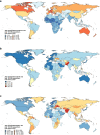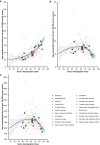The global, regional, and national burden of cancer among adolescents and young adults in 204 countries and territories, 1990-2019: a population-based study
- PMID: 34108026
- PMCID: PMC8191013
- DOI: 10.1186/s13045-021-01093-3
The global, regional, and national burden of cancer among adolescents and young adults in 204 countries and territories, 1990-2019: a population-based study
Abstract
Background: Accurate appraisal of burden of adolescents and young adults (AYAs) cancers is crucial to informing resource allocation and policy making. We report on the latest estimates of burden of AYA cancers in 204 countries and territories between 1990 and 2019 in association with socio-demographic index (SDI).
Patients and methods: Estimates from the Global Burden of Disease study 2019 were used to analyse incidence, mortality, and disability-adjusted life years (DALYs) due to AYA cancers at global, regional, and national levels by sex. Association between AYA cancer burden and SDI were investigated. Burdens of AYA cancers were contextualized in comparison with childhood and older adult cancers. All estimates are reported as counts and age-standardized rates per 100,000 person-years.
Results: In 2019, there were 1.2 million incident cases, 0.4 million deaths, and 23.5 million DALYs due to AYA cancers globally. The highest age-standardized incidence rate occurred in Western Europe (75.3 [Females] and 67.4 [Males] per 100,000 person-years). Age-standardized death (23.2 [Females] and 13.9 [Males] per 100,000 person-years) and DALY (1328.3 [Females] and 1059.2 [Males] per 100,000 person-years) rates were highest in Oceania. Increasing SDI was associated with a higher age-standardized incidence rate. An inverted U-shaped association was identified between SDI and death and DALY rates. AYA cancers collectively is the second leading cause of non-communicable diseases-related deaths globally in 2019. DALYs of AYA cancers ranked the second globally and the first in low and low-middle SDI locations when compared with that of childhood and older adult cancers.
Conclusion: The global burden of AYA cancers is substantial and disproportionally affect populations in limited-resource settings. Capacity building for AYA cancers is essential in promoting equity and population health worldwide.
Keywords: Adolescents and young adults; Cancer; Global burden of disease study; Mortality; Prevalence.
Conflict of interest statement
The authors declare that they have no competing interests.
Figures





References
-
- United Nations. Sustainable development goals: knowledge platform. 2016. https://sustainabledevelopment.un.org. Accessed 4 Nov 2020.
-
- United Nations General Assembly. Political declaration of the third high-level meeting of the General Assembly on the prevention and control of non-communicable diseases. 2018. http://www.un.org/en/ga/search/view_doc.asp?symbol=A/RES/73/2. Accessed 10 Sept 2020.
-
- Institute for Health Metrics and Evaluation (IHME). Global Burden of Disease Study 2019 (GBD 2019) population estimates 1950–2019. http://ghdx.healthdata.org/record/ihme-data/gbd-2019-population-estimate.... Accessed 18 Oct 2020.
Publication types
MeSH terms
LinkOut - more resources
Full Text Sources
Medical

